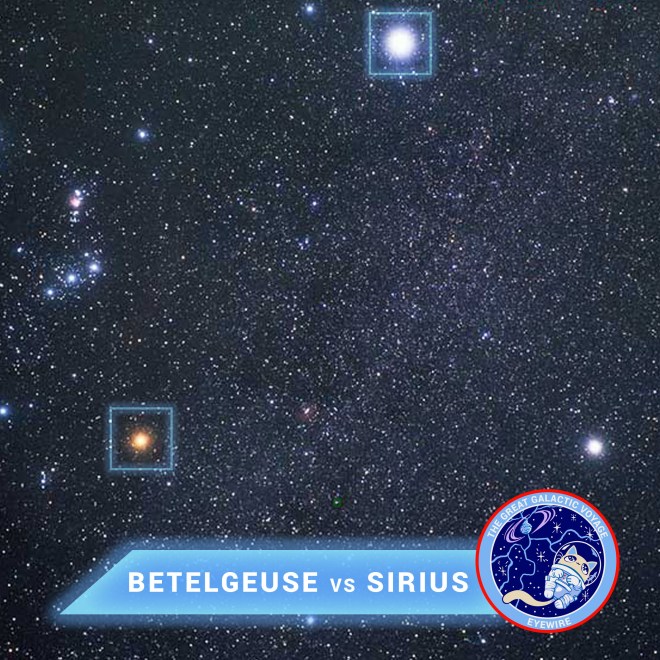Great Galactic Voyage: Betelgeuse vs. Sirius
The next two stops we’re going to make on our galactic voyage are a couple of special stars. First is Betelgeuse, one of Orion’s “arms,” which for Earth observers looks like it’s near the Orion Nebula, but like all constellations, Orion is only a shape we can form from our own perspective down here! The actual distance between the Orion Nebula and Betelgeuse is probably more than 700 light years. And the second star we’re visiting is Sirius, often called the “Dog Star” for its prominent spot in the constellation Canis Major. Sirius is quite close to our own Sun, at “merely” 8.6 light years!
What makes these stars similar, and what makes them distinct? The main thing they have in common is how they’re very easy to find from Earth, even in areas with heavy light pollution, and with the exception of certain extreme latitudes, your hemisphere doesn’t matter. If you can find any stars besides the North Star, you might know these! But here’s how they differ…
Betelgeuse
- This red supergiant is so visible because, well, it’s huge! Its mass is about 10-20 times that of the Sun. If we could see infrared light, it would be the brightest star in our night sky.
- Betelgeuse is the kind of star that lives fast, speeding down the galactic highway in its convertible. At 10 million years old, it’s quite young, but due to size it will probably form a spectacular supernova in a few million years more.
- What’s with the name? It’s derived from an earlier Arabic form, either Ibṭ al-Jauzā’, Yad al-Jauzā’, or Bait al-Jauzā’. No two astronomers will agree on how you should really pronounce it, so if you want to say beetlejuice, go right ahead!
Sirius
- This star kind of has a split personality. A binary system, its components are Sirius A (a typical white star that’s about twice the Sun’s mass), and Sirius B (a white dwarf). They orbit each other about every 50 years.
- While Sirius A and B are both less luminous than stars like Betelgeuse or Rigel, they’re so close to Earth that they’re the brightest star we can see, and will stay that way for 210,000 more years, though gradually you’ll only get to see them in the Southern Hemisphere.
- The Latin name Sīrius comes from the Greek Σείριος, which means “scorcher,” probably because it rises during the hottest days of the Northern Hemisphere. The Dog Star is what gives us “the dog days of summer!”
Which star do you go starry-eyed for? The faceoff starts at 11:00 AM EDT on 6/25 and goes for 24 hours! Usual VS bonuses apply.
Swag (generously sponsored by @susi): The top scoring player on the winning team wins 1 pack of glow-in-the-dark stars and 1 patch! Also, among the top 50% of players on the winning team, 1 player will be raffled the same prizes, and 3 more players will be raffled patches.
Artwork by Daniela Gamba
(Image source: NASA)
